- Latest reviews
- Culture
- Live reviews
- Sydney live reviews
Sweeney Todd is the perfect show to get your loved ones into musicals
By John Shand, James Jennings, Harriet Cunningham, Cassie Tongue and Peter McCallum
MUSICAL THEATRE
Sweeney Todd: The Demon Barber of Fleet Street ★★★½
Sydney Opera House, until August 27
Audiences can’t get enough of murderous barber Sweeney Todd, whose victims died “impeccably shaved.” Before the first serialised Sweeney story (from 1846) had even reached an ending, he was already the subject of a play.
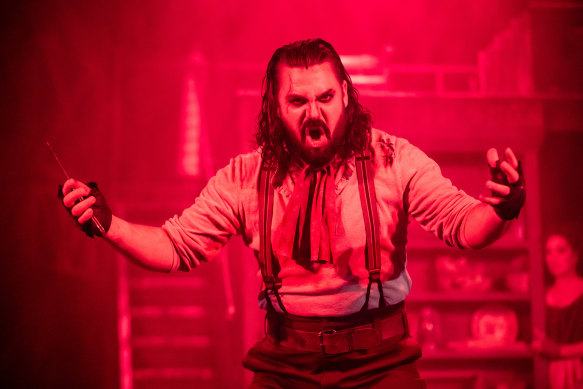
Ben Mingay stars in Sweeney Todd at the Sydney Opera House.Credit: Daniel Boud
It was another play, a century later, that inspired Stephen Sondheim to create his own Grand Guignol musical masterpiece. It’s a dark operetta (with book by Hugh Wheeler) that features glittering-sharp lyrics and melodies, as well as a rich backstory for Sweeney (he is seeking revenge for the assault of his wife and kidnapping of his daughter).
Director Stuart Maunder has an appealingly straightforward approach to directing musicals, which is on full display here in this Victorian Opera/New Zealand Opera co-production: cut to the heart of the story, stuff the cast with exceptional singers, and make room for acting, so the biggest moments tug at the heart.
The result is a Sweeney Todd that displays the power, if not the full potential, of the work: Roger Kirk’s set is appropriately spooky, though uses blood and gore sparingly. The nine-piece orchestra (Simon Holt is conductor and musical director) responds to Sondheim’s musical challenges – counterpoint, tonal tension and complex harmonies – adeptly, though the theatre’s sound system occasionally renders it hollow.
But it works: the ensemble swiftly establishes the high melodramatic stakes of the show, and each character feels rightly fuelled by their internal and sometimes competing motivations.
Ben Mingay’s Sweeney is driven by a bass-baritone voice stacked full of shadows – he plays a distant and disturbing figure with just enough of an undercurrent of black humour to keep him afloat. He’s well-matched by Antoinette Halloran, a fearlessly funny Mrs Lovett. By the time young Tobias (Jeremi Campese) is swearing to protect Mrs Lovett from Sweeney in a standout study of bravado masking vulnerability, it’s all near impossible to resist.
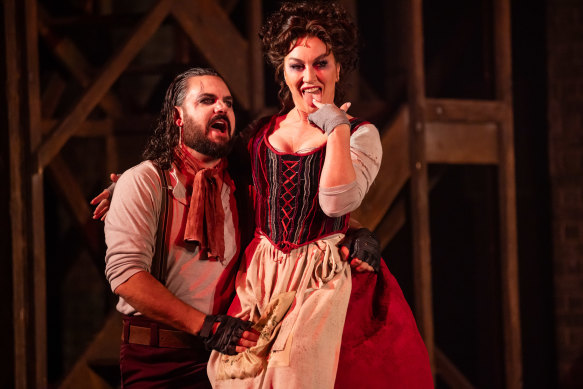
Antoinette Halloran is fearlessly funny as Mrs Lovett.Credit: Daniel Boud
Ultimately, the production is a valuable specimen: even though it plays things safe, it ensures every line is weighted, measured, and placed in context before it is spoken or sung; it summons a gothic sense of dread that encourages us to laugh at fear; it doesn’t get in the way of one of Stephen Sondheim’s greatest works. It’s the perfect production to introduce a loved one to musicals. You’ll have them hooked.
Reviewed by Cassie Tongue
THEATRE
Fade ★★★★½
Riverside Theatres, until August 5
Camila Ponte Alvarez brings such vivacity to the role of Lucia as to make every line spit and sizzle with humour, contempt, joy, angst and scheming calculation. Her eyes flash as her arms, hands and fingers continually trace acute angles in the air – just as her character is trying to get an angle on her job; trying to get an angle on being Mexican in the USA.

Camila Ponte Alvarez stars as Lucia in National Theatre of Parramatta’s Fade.Credit: Phil Erbacher
Having published a novel, Lucia has been picked up by a Hollywood studio as a token Latina in a factory churning out TV scripts. It’s a very white-bread world, except for Abel (Caspar Hardaker), a cleaner of Mexican heritage. Tanya Saracho’s dazzling, sassy, endlessly pertinent play (here having its Australian premiere) explores the relationship between these two “foreigners” in what has become their homeland.
The dramatic irony is low-hanging fruit throughout, as Lucia’s complaints about the way she is treated – right from having her name mispronounced, it being Loo-see-a in Spanish – are matched by the classist, racist assumptions she makes about Abel (A-bel) and he makes about her.
Hardaker is equally good in what is mostly the more wary, impassive role, listening to Lucia’s rants and tantrums, before he fully rises to the challenge of recounting the domestic horrors of Abel’s failed marriage. Under Jeneffa Soldatic’s direction (for National Theatre of Parramatta), there’s a deep truth between these two actors as their characters start to bond; as Lucia learns Abel’s secrets, and he learns just how manipulative she can be.
Abel is as earthy as Lucia is flighty, and the performers ensure we swiftly come to like them both, before the play follows them across the passage of a couple of months.
It’s all set in Lucia’s office, the conceit being that she works late, which is when he’s vacuuming, emptying her bin, fixing her collapsing shelf and unstable desk, and, in a cute metaphor, setting up a new lamp to shine a light on her life.
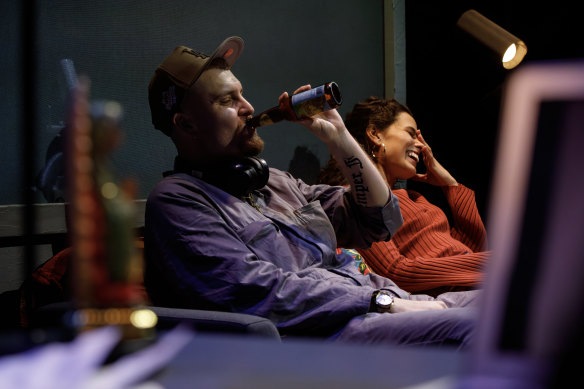
Alvarez and Caspar Hardaker give two of the performances of the year.Credit: Phil Erbacher
Across the one hour and 30 minutes, Lucia changes, the industry she started off despising having messed with her moral compass. Abel, by contrast, never loses track of due north. Melanie Liertz’s set, Rita Naidu’s costumes, Daniel Herten’s music and Jasmine Rizk’s lighting all contribute, without distracting us from two of the performances of the year.
Reviewed by John Shand
THEATRE
Tim ★★★
Glen Street Theatre, until July 30
There is a moment in Tim when you forget that you are sitting in a theatre and, instead, become totally invested in the characters, as if they are real people. Until that moment, which occurs about halfway through the 90-minute show, the performances can sometimes feel awkward: the action jumps between short scenes that, like the central character himself, are strangely uncomfortable. Characters talk at each other but rarely listen.
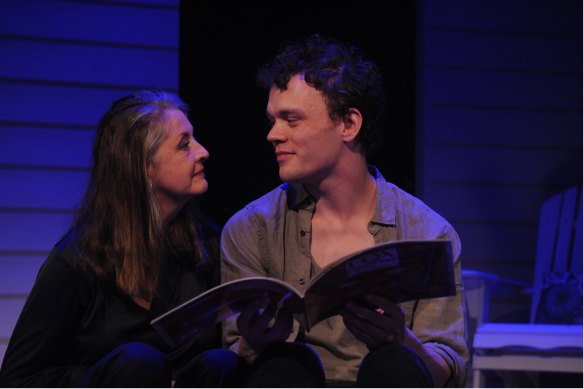
Jeanette Cronin and Ben Goss play people in a May-September romance in Tim.Credit: Branco Gaica
But when successful businesswoman Mary takes her gardener, Tim, up the coast to spend time at her weekender, the pace slows, the birds sing, and it all begins to make sense. It’s the moment where you realise that a young man with intellectual disability and an older woman have as much reason, and as much right as anyone else, to fall in love.
Writer Tim McGarry has created a thoughtful and provocative adaptation of Colleen McCullough’s first novel, Tim. McCullough wrote the unconventional romance while working as a medical researcher in the neurology department of Yale Medical School. The book (which is also the subject of the 1979 movie of the same name, starring Mel Gibson) is ahead of its time in its engagement the invisibility of certain people.
But although McGarry has dragged the action into the 21st century – complete with smartphones and Google – Tim still clings to a dangerous nostalgia for 1970s Australia, in the same way that, perhaps, we cling to conventional ideas of love, romance and disability.
Ben Goss plays Tim with the lightest of touches: he just is, while Jeanette Cronin, as Mary, undergoes the most radical transformation. Andrew McFarlane is unexpectedly touching as Ron, Tim’s father, while Valerie Bader leaps skilfully between two very different roles.
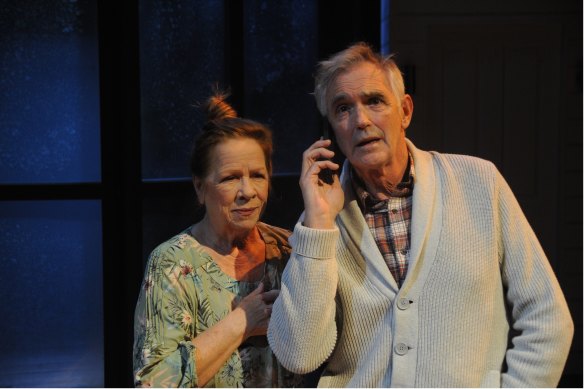
Valerie Bader and Andrew McFarlane play Tim’s parents, Emily and Ron.Credit: Branco Gaica
The set, designed by James Browne, features a small revolve that can create different spaces within moments – also helped by Max Lambert’s underscore, which steps in to change the mood.
There are a few missteps along the way. The sound on opening night was uneven, and having the cast miked detracted from the intimacy of a small theatre.
Explaining the disability sector in one brief scene is never going to be easy, and we probably don’t need an onstage death-with-shopping-bags scene. But Darren Yap’s pacy direction and a strong cast make up for the occasional clunks.
All in all, there is much to like and, yes, much to love about Tim.
Tim is also at Civic Theatre, Newcastle, August 4; The Joan, August 11 to 12; Merrigong Theatre Company, Wollongong, August 16 to 19; and Riverside Theatres, August 30 to September 2.
Reviewed by Harriet Cunningham
MUSIC
Jeonghwan Kim ★★★½
Sydney Conservatory of Music, July 28
Jeonghwan Kim began Beethoven’s Les Adieux sonata, Opus 81a, in a mood of reflective quiet, the sound veiled and distant.
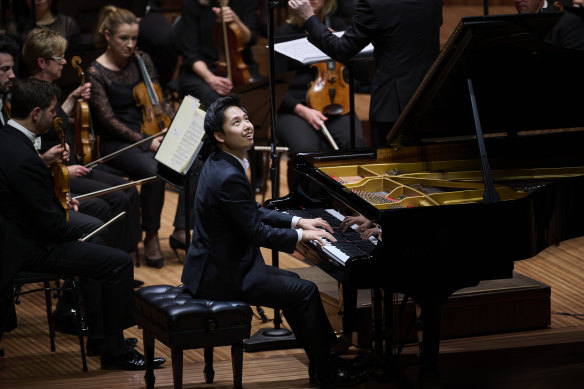
Jeonghwan Kim won this year’s Sydney International Piano Competition.Credit: Jaimi Joy
Beethoven had in mind the forced departure from Vienna in 1809 of his patron Archduke Rudolf to escape Napoleon’s advancing armies, and one could almost see the carriage disappearing into the dust.
Kim combined scurrying energy with carefully placed articulation in the first movement, and displayed distracted dreaminess in the second, before leaping into the finale with headlong velocity.
This concert was part of Kim’s nationwide victory lap after winning the 2023 Sydney International Piano Competition.
If Beethoven’s sonata demonstrated his ability to engage classical repertoire with discursive seriousness, the next work, Prokofiev’s Sonata No. 6 in A major, Opus 82, and the last work, Bartok’s Out of Doors suite presented a pianist who strives to make his greatest impression through force and speed.
The first movement of the Prokofiev sonata was frenetic and brutal and in the second, Kim emphasised Prokofiev’s sardonic and grotesque side. He allowed the third to achieve some stillness and feeling, particularly towards the end. The finale was a little too fast for my taste, losing clarity of rhythm and articulation.
Kim began the second half with the four Night Pieces by Robert Schumann. The works suggest Schumann’s own night thoughts were fevered and excitable (they were written in the shadow of his brother’s death) and Kim played the solemn march of the first piece with gentle whimsy and the second with animated wildness.
Chopin’s Berceuse, Opus 57 created a softly lulling interlude that Kim embroidered with delicate pianistic filigree.
The first movement of Bartok’s Out of Doors suite, With Drums and Pipes, is a raucous folk-inspired piece in which the drums are evoked by two-note clusters from the piano’s lowest notes. To the chagrin of the pearly toned Fazioli grand piano he was playing, Kim ostentatiously hammered out the more emphatic ones with the side of his hand in a karate chop of lusty ferocity.
The centrepiece of the work, The Night’s Music, created a moment of stillness though it could have tolerated more differentiated layering. The last movement, The Chase, with barking yelps in the piano’s treble, was quick and cruel.
Kim embarks on the next stage of his artistic development with an engaging ability to excite audiences and commanding technical prowess.
Reviewed by Peter McCallum
MUSIC
Eagles of Death Metal ★★★½
Enmore Theatre, July 27
Eagles of Death Metal (EODM) singer and guitarist Jesse Hughes arriving on stage, impishly dancing in a red satin cape while instigating a raucous singalong of Time Warp from The Rocky Horror Show, may seem like a weird way to kick off a gig, but it makes perfect sense.
Like that school disco staple, EODM revel in being a lot of fun, a little bit dumb, and sexy in the campiest way possible, creating a gateway to a retro fantasy world where the party never stops and the air is thick with irony.
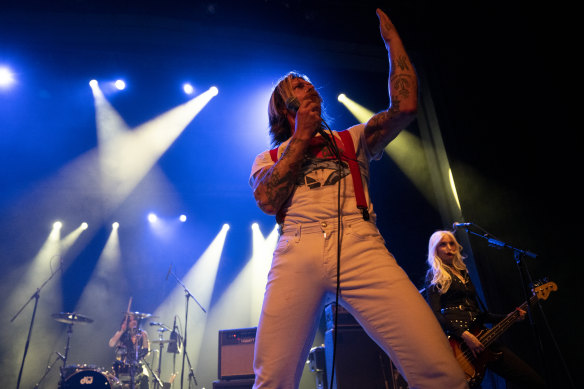
Don’t write off the rock’n’roll of Eagles of Death Metal.Credit: Janie Barrett
Hughes and the band, with their assorted handlebar moustaches, sequinned jumpsuits and vests, look like they’ve been pulled out from under tables at the Sunset Strip’s Rainbow Bar & Grill circa the 1970s – so it would be easy to write off the group as tawdry rock’n’roll cosplay.
But if it’s all a bit of a joke – the band’s name indicates it is – Hughes and the gang are 100 per cent committed to the bit, which they pull off credibly with an arsenal of blues-via-the-Rolling-Stones riffs that get the blood pumping.
EODM’s musical palette may be limited, but when they nail the brief of “blistering riff plus catchy chorus in three minutes or less”, as they do on hip-shakers like I Only Want You, I Want You So Hard (Boy’s Bad News) and Whorehoppin’ (Shit, Goddamn), they prove why tropes such as mic twirling and back-to-back guitar playing can still draw a crowd.
Much like ’80s hair-metallers Poison, EODM are here for nothin’ but a good time, which is appreciated, but the music never slows down to offer any depth or insight into who Hughes is once the party stops. For a man of 50, you’d expect he’s got enough war stories to add a bit more substance to the songwriting on occasion.
For now, it’s less about middle-aged contemplation and more about swaggering, youthful rock’n’roll fantasies shared by both audience and band, a desire encapsulated perfectly when the band do a rousing cover of David Bowie’s Moonage Daydream.

Eagles of Death Metal encouraged the audience to indulge in a rock’n’roll fantasy.Credit: Janie Barrett
The live-fast-die-young dream may be over once the lights come on and real life rudely interjects, but for a good hour-and-a-half on this night, everyone got to time warp and pretend they had moves like Jagger at a never-ending party for the eternal teenager within.
Reviewed by James Jennings
THEATRE
The Turn of the Screw ★★★½
Seymour Centre, until August 12
Fear turns to terror when our imaginations go to work upon the facts, as Henry James understood so well. By not explaining the ghostly phenomena in The Turn of the Screw, he engaged his readers’ imaginations, and by keeping the ambiguities alive until the end, he made a little masterpiece that readers keep reading, academics keep interpreting and other artists keep adapting.
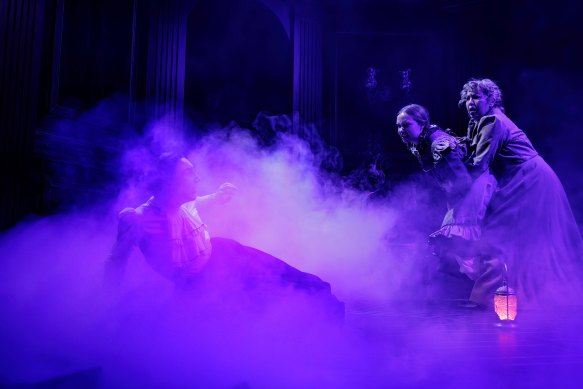
Lucy Lock, Kim Clifton and Martelle Hammer star in a new adaptation of Henry James’ gothic novella.Credit: Phil Erbacher
Writer-director Richard Hilliar is the latest to adapt the novella in this Tooth and Sinew production. In a program note, he speaks of embracing the story’s “utter commitment to ambiguity”, and he certainly does that in the first half, when the tension builds slowly, but inexorably.
This is as the governess (Lucy Lock) comes to suspect that her young charges, Flora (Kim Clifton) and Miles (Jack Richardson), might be hiding something sinister from herself and the housekeeper, Mrs Grose (Martelle Hammer).

The performances in The Turn of the Screw are matched by the production value.Credit: Phil Erbacher
In the second half, however, this commitment to ambiguity – essentially whether the ghosts are real or the governess’s hallucinations – unravels somewhat when some bouts of hysteria suggest the children might be possessed. Gulp.
Essentially Hilliar has taken James’ setting (a country house in 19th-century Essex), his mood (gothic) and his story-shape (suspenseful), and then fiddled with the precise incidents. Had he fiddled less in the finale, he would have done his play a favour.
Nonetheless, this is mostly a gripping piece of theatre. The first half flies by while one is still entranced by the nuances of the characters and performances.
Initially Hilliar has Lock present a less formal incarnation of the governess as she accepts the job from the children’s uncle (Harry Reid), but the characterisation settles as she bonds with her charges, and forms a wary friendship with Mrs Grose.
Clifton and Richardson – both adults – are entirely credible as the children, striking a balance between outward charm and inner secrecy. Hammer nails the bewildered Mrs Grose, her Essex accent unflinching in the face of events that might drive a woman to drink.
The quality of the performances is at least matched by the production values. Hamish Elliot’s wood-panelled set rises to meet a plant-like growth, just as the tiled floor gives way to grass and reeds at the downstage edge, as if Mother Nature is reclaiming what was once her own. Ryan McDonald’s lighting compounds the creepiness, and Chrysoulla Markoulli’s music intensifies it still more.
Reviewed by John Shand
The Booklist is a weekly newsletter for book lovers from books editor Jason Steger. Get it delivered every Friday.